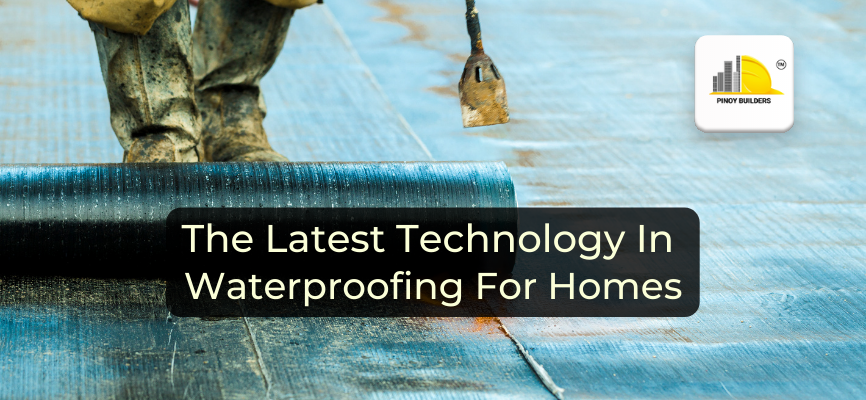Our homes serve as more than a place of comfort for our family. Homes serve as a place of refuge from external weather forces like the harsh rays of the sun, strong winds, extreme temperatures, and strong downpours. As much as homeowners always like to make the interior of their homes as cozy and comfortable as possible, it is also important to make sure that the exterior is secure and safe from the external elements that may penetrate and affect the safety of the home.
In the Philippines, the rainy season is always anticipated to bring heavy rainstorms and numerous typhoons–and this is especially emphasized by the weather changes that the world is currently experiencing due to global warming. Typhoons nowadays are becoming more and more unpredictable, and the need for better and more effective waterproofing technology is needed. In this article, we will discuss some of the latest innovations in waterproofing technology that can help improve the typhoon resistance of homes.
The Latest Technology In Waterproofing For Typhoon Resistance

Image from Asian Paints
The need to improve the current technology is always there, as humans tend to find more and better ways to live. To further improve the protection of our homes from external forces like strong winds and heavy typhoons, newer and better-advanced technology is developed. Below are some of the newest innovations for waterproofing homes and improved typhoon resistance.
Crystalline Waterproofing

Image from Costrofacilitator
Applied topically on the concrete block or integrated directly into the concrete mix, crystalline waterproofing is an innovation in waterproofing technology that can be used in home construction and other building projects. Crystalline waterproofing is done through the chemical activation of crystal properties that were applied directly on the surface of the structure or mixed into the concrete. These crystalline properties will then create a water-resistant barrier on the surface of the material on which it is applied. These tiny crystals are meant to fill in the tiniest pores and cracks of a material in order to create a watertight surface that liquid cannot easily penetrate.
Polyurea-Waterproof Coating

Image from isomat
Used in industrial and commercial applications, polyurea-waterproofing coatings are applied in building materials and structures in order to maximize their waterproofing capabilities and significantly reduce the damage that constant exposure to water over time can cause. Polyurea can be applied as a coating over building materials to create a thick and highly resistant, waterproof barrier for the structure. A polyurea coating is also beneficial to construction professionals because this material has a significantly less cure time, which can increase the efficiency of operations.
Self-Healing Waterproofing Membrane

Image from Sika Hong Kong – Sika Group
Another latest innovation in waterproofing for the construction of homes is the technology of self-healing liquid-resistant membranes. Unlike other waterproofing materials that block the water by creating an impermeable barrier, a self-healing waterproofing membrane is made of non-woven fleece that is water-absorbent and water-swelling. The water-swelling feature of a self-healing membrane allows the textile to create another layer of waterproof barrier if the outer layer is damaged.
A self-healing membrane in a waterproofing system is also thin and lightweight, which makes installation easy. This waterproofing innovation can also be used for tunnel sealing because it is also resistant to cracking and other damage.
Waterproofing For Safer Homes
Waterproof roofs are necessary for ensuring the safety of our homes from strong winds and heavy downpours, but waterproof walls are also as important. Utilizing these latest innovations in waterproofing technology will enhance the water resistance of homes, and it will also ensure that the home’s edifice will remain safe from the damage that constant water exposure can pose to the home. By adopting these advancements in waterproofing technology in home construction, homeowners can enjoy a sturdy home that is safe from typhoons and other uncontrollable external forces.
References
- BPA-waterproofing.com. (n.d.). Non-woven waterproofing membrane BPA-EasySeal / BPA-SilverSeal. BPA-waterproofing.com. Retrieved August 14, 2023, from https://bpa-waterproofing.com/en/products/external-surface-waterproofing/non-woven-waterproofing-membrane
- Brown, C. (2023, May 19). Crystalline Waterproofing: The Science Behind It & Why It’s Important – Blog. W. R. Meadows. Retrieved August 14, 2023, from https://www.wrmeadows.com/blog/crystalline-waterproofing-systems/
- Elastochem. (2023, March 20). The Benefits of Polyurea for Waterproofing. Elastochem. Retrieved August 14, 2023, from https://elastochem.com/news/the-benefits-of-polyurea-for-waterproofing-concrete
- Joshi, P. (2023, March 12). Three Latest Innovations in Waterproofing Technology for Indian Structures. Industry Outlook. Retrieved August 14, 2023, from https://www.theindustryoutlook.com/services-and-consulting/panorama/three-latest-innovations-in-waterproofing-technology-for-indian-structures-nwid-4065.html
- PropertyHome. (2023, May 29). Unveiling the Future of Waterproofing: Innovations and Breakthroughs in 2023 – PropertyHome. PropertyHome. Retrieved August 14, 2023, from https://propertyhome.in/unveiling-future-waterproofing-innovations-breakthroughs-2023/










